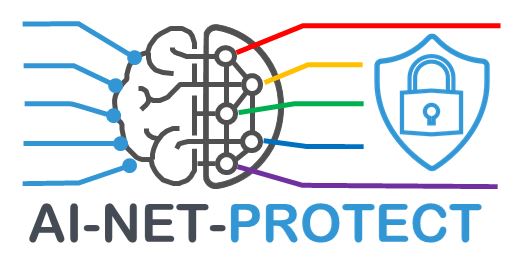
| Project Home: | www.celticnext.eu/project-ai-net-protect/ |
| Funding Agency: | BMBF |
| Duration: | 3 years, February 2021 - January 2024 |
| Contact: | Maximilian Stephan (maximilian.stephan@tum.de) |
| Patrick Krämer (patrick.kraemer@tum.de) | |
| Andreas Blenk | |
| Prof. Wolfgang Kellerer (wolfgang.kellerer@tum.de) |
Scope of Project
Digital transformation is ongoing in many areas of today’s society, which will impact many aspects of people’s lives via means such as smart cities, robotics, transportation, and next-generation industries. At the same time, the current centralized cloud infrastructure is not adequate to serve the transformation’s requirements. We believe that three technologies can come together to shape a new secure service and application platform: 5G, edge-centric compute, and artificial intelligence. In this context, European industry has a good position in 5G networks, transportation and industrial applications, but needs to strengthen the position in secure cloud, data centre and artificial intelligence technologies to be at the forefront of development.
The primary focus of the AI-NET-PROTECT sub-project is to provide automated resilience and secure networks operated on trusted equipment to critical infrastructures and enterprises. AI-NET-PROTECT will ensure the protection of critical data, network performance (like latency, throughput, availability), and infrastructure (against tampering and attacks). To achieve these objectives, the project will develop a scalable network and node architecture to address the diverse KPIs by a mix of open and purpose build hardware and software including whiteboxes. Network telemetry and intent-based software-defined network management and control will provide zero-touch provisioning and support artificial intelligence based automation of end-to-end services. Strong security based on multi-layer cryptography, agile crypt-functions, and quantum-safe algorithms will form an integral part for the developed architecture. The key use cases for AI are performance optimization, proactive fault and anomaly detection, penetration and vulnerability testing, and security incident management.
Contributions
1. Network Monitoring
1.1 Data Collection
Among other things, SDN-Controllers, OpenFlow- and P4-based network devices are evaluated in terms of available data and collection interfaces.
Further, optical networks, that allow for a reconfiguration of topology should be evaluated in the same context.
For that, the Optical Circuit Switch available at the chair is included into the overall model.
1.2 Data Analysis
With collected data, global models for network representation are evaluated.
Because such global models are based on data from distributed network elements, two key questions to be answered are:
- Which data to collect?
- How frequent to collect relevant data?
To get more meaningful insights about underlying structures and dynamics machine learning methods like Stochastic Block Models are applyed to the collected data.
2. AI-supported Network Operations
Insights from 1.2 are used to make statements about the network state and predictions about future network behavior.
Both will be utilized to improve decision making in regards to network operations.
This can include improved long-term strategies in context of e.g. resource allocation, as well as a fast response to the occurrence of network anomalies.
This work is partially funded by Germany Federal Ministry of Education and Research (BMBF) under the project ANTILLAS (grant ID 16KIS1318)
Funding
This work is partially funded by Federal Ministry of Education and Research in Germany (BMBF) as part of the project AI-NET-PROTECT (grant ID 16KIS1294).